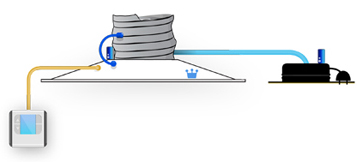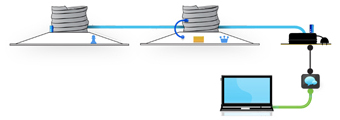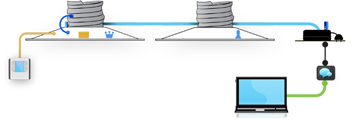 |
|
Electronic VAV Diffusers
The Rickard range of VAV electronic diffusers has been developed as an intelligent and complete system that can work on its own or when integrated into a BMS. The system aims to provide superior thermal comfort in every part of a building while minimising energy consumption and maintaining effective air mixing.
Electronic diffusers can be individually programmed to provide occupants with total control over their environment. This can be achieved in both single diffuser, single office applications and large open areas where a number of diffusers are required.
|
|
System flexibility
System flexibility The Rickard range of VAV electronic diffusers uses a modular system design that is extremely reliable and easy to install. It can be used with most types
of buildings, regardless of their size,
due to the simplicity of its design
and the flexibility of the system software.
It is made up of six core components:
- The Master Communication Unit (MCU)
- On-board master Controller
- Master diffuser
- Wall thermostat
- Diffuser
- Power Supply
The system can be very simple with one Rickard diffuser, controlled by either the on-board master controller or a wall thermostat.

The system can also be scaled up. A maximum of 60 diffusers can be accommodated on a single Master Communication Unit (MCU) and multiple MCU’s can be connected to the BMS if more than 60 diffusers are required. Up to 15 diffusers can be connected to a single power supply, and these can be split into multiple zones.
The diffusers can be individually controlled by either a wall thermostat or the on-board controller that sends its signal back to the BMS. The entire system is then monitored and changes are made through a PC using the Rickard stand-alone software
or a BMS.
Rickard Electronic diffusers have adopted an easy to install “plug and play” system that uses simple, automotive grade, daisy chain connections. This helps to minimise the cost of installation and eliminates the risk of using the incorrect connectors.
For new installations of Rickard Electronic Diffusers, duct design that achieves static regain is highly recommended. If retrofitting to existing ducting that cannot be changed, a relief ring can be installed at the end of a duct run to release air pressure when the diffusers close.
Rickard VAV diffusers are easy to install and set up, and will function effectively when the building’s air conditioning systems are in either cooling or heating mode. All Rickard ceiling diffusers are either installed in suspended
tiled ceilings with “T” frames or standard plaster board using a standard ceiling frame.

|
The flexibility of the Rickard electronic VAV system enables it to be installed in both small single diffuser applications and large multi level projects involving thousands of diffusers.
The Rickard design examples shown below illustrate the flexibility of the system.
|
 |
 |
|
|
 |
 |
|
|
|
Combinations are possible where room temperature is read from diffuser, set point read from wall thermostat and diffusers monitored from Rickard software.
|
|
Flexible control options
A key benefit for any electronic ventilation system within a building is its compatibility with a range of control systems. The Rickard wall thermostat can control a single diffuser or up to 60 diffusers.
The standard thermostat monitors temperature and controls the set point, while the version with occupancy sensing can detect a vacant zone, and through the BMS, automatically switch off that zone. Generally for larger more complex applications, the electronic diffusers connect to the BMS protocols on the market; LonWorks and BACnet or the Rickard standalone software. |
| Easy to install, commission and re-program |
Rickard’s easy to use software is perfect for all applications where a BMS system is not being utilised within the building. This standalone software has been developed for commissioning and setting diffuser parameters, monitoring the network and logging diffuser activity. Its user friendly graphics have easy to follow instructions and simple colour-coded diffuser icons for set up and commissioning. This software makes it simple to convert a slave diffuser to a master,
set minimum and maximum temperature settings, and perform all commissioning from below the ceiling with a PC. Changes to office layouts are easy as each diffuser can be easily
re-positioned and re-programmed according to its new environment. |
The software allows you to view and monitor the temperature conditions of up to 15 diffusers at a time and 60 diffusers (one MCU) in total.
It also allows you to view additional groups of
up to 60 diffusers. The system can also log faults, which ensures that any issues can be detected centrally and resolved with the full view of the entire system.
The Rickard software can show you how each diffuser is connected within the zone and which diffusers make up each zone. By selecting
the diffuser parameters you wish to log, data can also be viewed in an easy to understand chart and exported for storage and analysis if required. This ensures that any corrections or adjustment to the system can be made accurately and with minimum disturbance to the building occupants. |
Occupancy Sensor |
Air Flow Sensor |
The Rickard VAV electronic diffuser system is also available with occupancy sensing capability.
This unique option is available within the diffuser itself and a specially designed wall thermostat, which means no additional sensor or wiring is required. This technology closes the opening of the diffuser if it detects the room to be unoccupied and opens it again when it detects an occupant present. The timing of this operation is controlled by an exit room delay which is factory preset to 15 minutes, but can be easily changed to best suit the individual occupant using the Rickard software.
If the diffuser with occupancy sensing is controlled by a BMS, it can also automatically turn the room lights off and on. This can lead to significant cost savings as the building requires less energy to operate its lighting and cooling/heating systems.
Occupancy sensing capabilities can also be added to an existing Rickard Electronic VAV system by replacing the diffuser and making alterations to the software settings. It can also be achieved by adding the wall thermostat with
occupancy sensing.
|
All Rickard electronic diffusers are also available with air flow sensing. This feature enables the commissioning to occur easier and faster, as air flow and total pressure measurements can be viewed
and monitored through the Rickard MLM software
and a BMS.
The Air Flow Sensor can be fitted to each diffuser for accurate air flow calculations, or to one diffuser per zone to provide an indication of air flow in that zone. The air flow sensing feature will also include a commissioning mode that will allow a maximum flow value to be limited to design volumes under maximum load conditions. This will ensure diffusers do not supply more air than intended.
|





